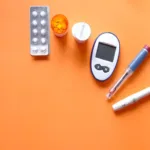Insulin resistance occurs when the body cells resist the signals from the hormone insulin. It is the major cause of Type 2 diabetes mellitus.
If insulin resistance is diagnosed in time you can actually reverse it and get back to the normal state before having type 2 diabetes.
The relationship between insulin resistance and type 2 diabetes has been understood for well over 50 years.
The importance of insulin resistance is that it not only serves as the most accurate predictor of the onset of type 2 diabetes, but it also serves as a therapeutic target once hyperglycemia has occurred. Some of the causes of insulin resistance in type 2 diabetes are the point of concern in this article.
| You may also like to read: |
Blood Sugar, Insulin, and Type 2 Diabetes
A major factor in the onset of type 2 diabetes is insulin. You cannot exist without this essential hormone, which governs the body’s intricate process of controlling blood sugar (glucose). This is how it normally works:
- Blood sugar is produced by your body from the food you eat.
- When blood sugar enters your system, the pancreas releases insulin as a response.
- In order for blood sugar to be utilized as fuel by the body’s cells, insulin aids in its absorption.
- Insulin sends a message to the liver telling it to store blood sugar for later use.
- Blood sugar levels drop as a result of this sugar entering cells, which instructs insulin to follow suit.
- In order to ensure that energy is constantly accessible, even if you haven’t eaten in a while, lower insulin levels signal the liver to release stored blood sugar.
The above-stated mechanism is how insulin normally works. This system can get out of hand and become unstable.
- The bloodstream absorbs a lot of sugar.
- To get blood sugar into cells, the pancreas releases more insulin into the body.
- Cells develop resistance to insulin over time and stop reacting to it.
- The pancreas continues to produce more insulin in an effort to get cells to react.
- When the pancreas eventually can’t keep up, blood sugar levels keep increasing.
Since too much blood sugar in the bloodstream is very bad for the body, it must be carried into cells as rapidly as possible.
The liver and muscles are also being told to store blood sugar with a large amount of insulin. The liver delivers extra blood sugar to fat cells for storage as body fat when the cells are full.
As a result, you put on weight. What’s worse is that this lays the ground for type 2 diabetes and prediabetes.
| You may also like to read: |
Causes of Insulin Resistance in Type 2 Diabetes
The precise mechanism through which insulin resistance arises is still mostly unknown to scientists. Numerous genes have been discovered thus far that influence a person’s propensity to develop insulin resistance. Furthermore, insulin resistance is more common in elderly individuals.
Insulin resistance can occur to varying degrees due to a number of situations and circumstances. Inactivity and extra body fat, particularly in the abdominal region, are thought to be the two primary causes of insulin resistance.
This table summarizes the causes of insulin resistance:
Modifiable Causes | Non-Modifiable Causes |
| Obesity | Genetics |
| Physical inactivity | Aging |
| Sleep deprivation | Certain medical conditions such as:
|
| Stress | |
| Smoking | |
| High-sugar, high-fat diet | |
| Gut microbiota imbalance | |
| Medications (such as corticosteroids) |
| You may also like to read: |
How to Reverse Insulin Resistance in Type 2 Diabetes
Insulin resistance can increase your chances of developing chronic diseases associated with type-2 diabetes. One must try his/her best to return the metabolic situation to normal as soon as possible.
One of the reasons why physical activity is essential for managing diabetes (and overall good health!) is that it increases your insulin sensitivity.
Do more exercise now, rather than after being told you have diabetes. You will do better if you act as soon as possible.
Along with controlling blood sugar levels, lowering stress, and getting adequate sleep (the physical activity can aid in this), losing weight is also crucial.
Your doctor or dietitian may advise limiting harmful fats, sweets, red meats, and processed carbs while avoiding consuming excessive amounts of carbohydrates, which encourage the development of excess insulin.
Instead, they’ll probably advise consuming a diet rich in whole foods, which includes more fruits, vegetables, whole grains, fish, and lean meat.
| You may also like to read: |
Symptoms of Insulin Resistance in Type 2 Diabetes
Since insulin resistance can only increase blood sugar, the following are the signs of insulin resistance.
- Heightened thirst
- Distorted vision
- Urinating often (peeing)
- Increased appetite
- Headaches
- Slow-healing wounds and sores
- Skin and vaginal infections
- Darkened skin areas in the armpit or neck
- Skin growths
- Changes in the eye
| You may also like to read: |
How is Insulin Resistance Diagnosed in Type 2 Diabetics?
Because there is no systematic testing, diagnosing insulin resistance can be challenging. You won’t experience any symptoms if your pancreas makes enough insulin to overcome the resistance.
Since there isn’t a single test that can accurately identify insulin resistance, your healthcare professional will take a number of things into account when determining whether you have the condition.
These include:
- Family history
- Physical exam
- Medical history
- Test results
- Signs and symptoms
Here are some of the tests that are used to diagnose Insulin resistance:
Fasting plasma glucose (FPG) test:
This test measures your blood sugar level after you have fasted for at least 8 hours. A level of 100 to 125 mg/dL indicates impaired fasting glucose (IFG), which is a sign of insulin resistance.
Oral glucose tolerance test (OGTT):
This test measures your blood sugar level before and after drinking a sugary drink. A two-hour blood sugar level of 140 to 199 mg/dL indicates impaired glucose tolerance (IGT), which is a sign of insulin resistance.
Hemoglobin A1C (HbA1C) test:
This test measures your average blood sugar level over the past 2 to 3 months. A level of 5.7% to 6.4% indicates prediabetes, which is a sign of insulin resistance.
HOMA-Insulin resistance test:
This test measures your fasting insulin level and glucose level and calculates a score called the homeostatic model assessment of insulin resistance (HOMA-IR). A higher HOMA-IR score indicates greater insulin resistance.
Hyperinsulinemic euglycemic clamp:
This is a more complex and invasive test that directly measures insulin resistance by infusing insulin into the bloodstream while maintaining a constant glucose level.
The rate of glucose infusion required to maintain the target glucose level indicates insulin resistance.
| You may also like to read: |
What happens to insulin and C-Peptide levels in individuals with Insulin resistance?
Insulin levels:
Initially, in insulin resistance, the body tries to compensate by producing more insulin to maintain normal blood sugar levels.
Therefore, insulin levels may be higher than normal in the early stages of insulin resistance. However, as the condition progresses, insulin production may decrease, leading to lower insulin levels.
C-peptide levels:
C-peptide is a byproduct of insulin production, and its levels are often used to assess insulin secretion.
In insulin resistance, c-peptide levels may be initially increased due to a compensatory increase in insulin production. However, as insulin production decreases, c-peptide levels may decrease as well.
| You may also like to read: |
Who is commonly affected by it?
Anyone may develop insulin resistance; you don’t need to have diabetes. Insulin resistance can be either transitory (taking steroid medicine for a short time might produce it) or chronic. Excess body fat, especially in the abdomen, and a lack of exercise seem to be the two primary causes of insulin resistance. [ref]
The majority of people with prediabetes and Type 2 diabetes have some degree of insulin resistance. Insulin resistance can potentially be a complication of Type 1 diabetes.
| You may also like to read: |
Conclusion:
Insulin resistance is a concerning condition, but it is treatable if detected early. You can always reverse this condition by implementing lifestyle changes such as regular exercise and a modified diet that results in at least a 5% weight loss.
A small amount of effort now can save you from Type 2 diabetes and its complications.



